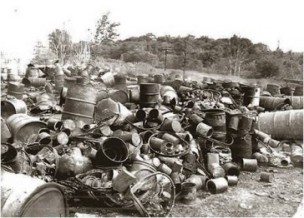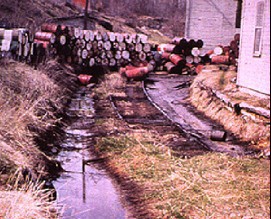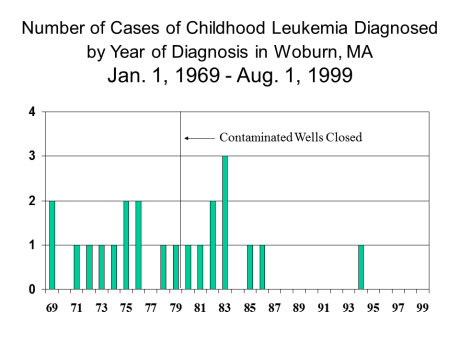The Link Between Disease and Exposure
The contamination of Wells G and H with TCE and PCE was discovered somewhat accidentally. Nearly two hundred barrels of improperly disposed of waste were discovered on a plot of land just north of the wells. While they were removed prior to contaminating the soil, a town engineer submitted samples of water from the wells that revealed high concentrations of TCE and PCE. In fact, it was this discovery of TCE and PCE in the wells and heavy metal contamination at the site of the old Merrimac Chemical Company that prompted Reverend Young to search for additional cases.


These events drew the attention of the Massachusetts environmental officials and the EPA who conducted the series of studies described previously in this module. They concluded that the incidence of leukemia in Woburn was higher than expected based on the statewide average, but now several questions remained to be answered:
- Who was responsible for contamination of the wells?
- To what extent had had the water supply been contaminated prior to 1979?
- Did the elevated concentrations of TCE and PCE in the wells cause leukemia in the children?
An Epidemiologist's View of Causation
How could we investigate the question "Did the elevated concentrations of TCE and PCE in the wells cause leukemia in the children?" First we would need to visit the concept of causation. In the video below Matt Fox, Department of Epidemiology at BUSPH discusses the concept of causality from an epidemiological as it relates to the Woburn case.
As we will see later in the module legal actions were beginning to take shape to uncover answerers to these questions. Jan Schlichtmann, the attorney prosecuting the case for the families whose children were victims of leukemia, summarizes the work that his team and collaborating scientists needed to bring together to be able to pursue the case in court.
Analysis of Contaminated Well Water and Health Effects
In 1982, Rev. Bruce Young and Anne Anderson, together with other members of the community group FACE, approached staff at the Harvard School of Public Health and asked for assistance in some kind of further health study. In the audio below, Phil Brown talks about the Harvard study team.
Dr. Marvin Zelen and Stephen Lagakos along with others at HSPH responded to FACE's request and planned a cross-sectional interview study to see if childhood leukemia, birth defects, and other childhood illnesses were associated with exposure to water from Wells G and H. By this time, there were a total of 20 childhood leukemia cases in Woburn (want to check this-RL). A major volunteer effort was mobilized, and over 5,000 households were contacted and queried about their health. When the results were presented in 1984, the first link to the Wells G and H was made in a scientific study. They concluded that the children who had leukemia received twice as much contaminated water as the children who didn't. This study also led to the recognition that ordinary citizens could play an important role in the design and conduct of epidemiological studies. Results of the study were published in 1986 in the Journal of American Statistical Association: An analysis of contaminated well water and health effects in Woburn, Massachusetts by Lagakos et al.
Review the study prior to answering the questions below.
In the video clip below, Dick Clapp, Professor Emeritus in Environmental Health at BUSPH discusses the Zelen and Lagakos study and some of the controversy surrounding this work.
The investigation in Woburn was driven by community concerns. Ann Anderson and others strongly suspected that something in the environment was responsible for the leukemia cases, but their concerns were largely dismissed by physicians and town officials. Ann Anderson and her minister, the Reverend Bruce Young formed and led the group FACE (For a Cleaner Environment), comprised mostly of many parents of sick children, as well as other concerned residents. In their efforts to get research that was responsive to their questions about the causes of Leukemia in Woburn, FACE provided one of the earliest examples of the community-based participatory research, or CBPR.
In the video below, Howard Cabral, Professor of Biostatistics at BUSPH discusses the training he received under the direction of Zelen and Lagakos prior to conducing the survey research that subsequently produced the 1986 study.
The discussion section of the article explained some of the challenges in understanding the nature of the relationship between wells G and H and the cases of leukemia. The table below provides an overview of these challenges.
Challenges to Establishing Causation Between
Contaminated Wells and Cases of Leukemia
- Knowledge
- There was a lack of knowledge about the contaminants in wells G and H and their potential health effects. While several of the chemicals detected in 1979 had been shown to cause cancer in animal studies, the effects of these chemicals on humans at lower concentrations, as well as in combination, were not well understood at the time.
- Timing
- The contamination (both types and levels) in wells G and H was unclear in the time period prior to 1979. This makes it difficult to determine the nature of contamination prior to 1979 including the levels, the duration of contamination, and whether there were other chemicals.
- Source(s)
- The EPA went on to conduct geological studies to determine the sources of the contaminants found in wells G and H and the surrounding groundwater. Investigators believed that these studies would make it possible to predict the types and levels of contamination in earlier years.
A key concern among citizens that remained after this study was whether individuals who were formerly exposed to wells G and H might still be at elevated risk. Investigators suggested one way to address this concern was to monitor adverse health outcomes in Woburn over subsequent years. Additional cases of leukemia occurred in Woburn children up until 1986. Woburn stood out throughout Massachusetts for its high childhood leukemia incidence, although the number of cases began to dwindle by the mid-1980s (see graph below).

The role members of FACE and other non-scientist Woburn residents played in this early example of Community Based Participatory Research cannot be underestimated. Educating others, whether they are residents, interested students, and researchers, or citizens from other communities with similar problems, was an important goal for Woburn activists. Dr. Phil Brown talks about the social and cultural context of the Woburn case and the important leadership qualities the community activists displayed and the commitment and courage one must bring to the task of empowering communities for change.
Further Health Studies (Mid-1980s and Beyond)
The Department of Public Health, with assistance from the CDC, organized a national advisory panel to recommend further studies in 1985. A birth outcomes study, termed the Woburn Environmental and Birth Study (WEBS), as well as a leukemia follow-up study, were recommended. The Agency for Toxic Substances and Disease Registry (ATSDR) provided funds for both, and these began in 1988-1989. The WEBS study was released in 1994, with generally negative results. Citizens critiqued it based on the timing of the contamination and the study period.
The Woburn Childhood Leukemia Follow-up Study was an expansion of the original 1981 DPH/CDC case-control study. The follow-up study included more cases and aimed to provide further insight into the causes of childhood leukemia in Woburn. Results were first publicly presented in June 1996 and formally released in 1997.
In 2002, results were published in the The Science of the Total Environment by Costas et al. View A case-control study of childhood leukemia in Woburn, Massachusetts: the relationship between leukemia incidence and exposure to public drinking water. In the video clip below, Kevin Costas discusses some of the key findings from the study, which suggested a link between pre-natal exposure to water from Wells G and H and risk of childhood leukemia.
Show Answer Given the results of these studies and the case made thus far, do you think that an association has been established between TCE and childhood leukemia? How should FACE and the affected residents of Woburn proceed?

